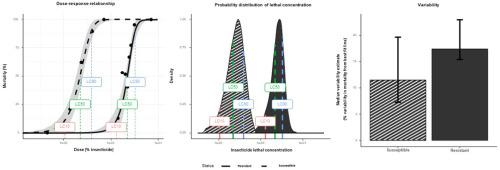Characterising the intensity of insecticide resistance: A novel framework for analysis of intensity bioassay data
Abstract
Insecticide resistance is a growing problem that risks harming the progress made by vector control tools in reducing the malaria burden globally. New methods for quantifying the extent of resistance in wild populations are urgently needed to guide deployment of interventions to improve disease control. Intensity bioassays measure mosquito mortality at a range of insecticide doses and characterise phenotypic resistance in regions where resistance is already detected. These data are increasingly being collected but tend to exhibit high measurement error and there is a lack of formal guidelines on how they should be analysed or compared. This paper introduces a novel Bayesian framework for analysing intensity bioassay data, which uses a flexible statistical model able to capture a wide variety of relationships between mortality and insecticide dose. By accounting for background mortality of mosquitoes, our approach minimises the impact of this source of measurement noise resulting in more precise quantification of resistance. It outputs a range of metrics for describing the intensity and variability in resistance within the sample and quantifies the level of measurement error in the assay. The functionality is illustrated with data from laboratory-reared mosquitoes to show how the lethal dose varies within and between different strains. The framework can also be used to formally test hypotheses by explicitly considering the high heterogeneity seen in these types of data in field samples. Here we show that the intensity of resistance (as measured by the median lethal dose (LC50) of insecticide) increases over 7 years in mosquitoes from one village in Burkina Faso but remains constant in another. This work showcases the benefits of statistically rigorous analysis of insecticide bioassay data and highlights the additional information available from this and other dose-response data.


 求助内容:
求助内容: 应助结果提醒方式:
应助结果提醒方式:


